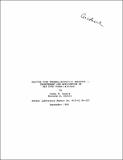| dc.contributor.author | Loomis, James N. | en_US |
| dc.contributor.author | Hinkle, William D. | en_US |
| dc.contributor.other | Consolidated Edison Company of New York, inc. | en_US |
| dc.date.accessioned | 2011-01-11T05:34:25Z | |
| dc.date.available | 2011-01-11T05:34:25Z | |
| dc.date.issued | 1980 | en_US |
| dc.identifier.uri | http://hdl.handle.net/1721.1/60478 | |
| dc.description.abstract | Several improvements have been made to COBRA-IIIC/MIT. All of the improvements, except for one, have been made in response to the recommendations of past research. The improvements are included in a new version of the code as new modeling options. The new modeling options overcome limitations and disadvantages of old modeling options. The improvements are as follows: 1. Addition of a new fuel pin conduction model which includes temperature dependent properties and burnup dependent gap heat transfer coefficient. 2. Addition of a new heat transfer package which covers a broad range of flow regimes and contains more consistent logic. 3. Addition of a quality dependent mixing model for two-phase flow. 4. Addition of new correlations for BWR, CHFR and CPR calculation. 5. Addition of new options for calculating transverse momentum coupling parameters use for the single pass method. | en_US |
| dc.description.abstract | The improvements have been tested individually and during application of the improved code to transient PWR and BWR test cases. Testing mainly involved comparison of the predictions of different modeling options and in some instances, comparison of predictions with experimental measurements. MDNBR, MCPR and MCHFR predictions showed only small sensitivities to the fuel rod and heat transfer modeling options used for the test cases analyzed. Differences in predictions of the old and new heat transfer models resulted in different clad temperature predictions. Clad temperature varies more smoothly in the axial direction when the new heat transfer model is used. The new heat transfer model predictions vary smoothly from one time step to the next with changing coolant conditions. Discontinuous change in old heat transfer model predictions caused failure of the flow solution to converge during transient BWR analysis. Fuel rod surface heat flux predictions of the old and new fuel rod models were close even though fuel rod temperature predictions showed some differences. The new mixing model did not improve subchannel flow and enthalpy predictions for BWR conditions. However, some improvement was seen in predictions for sub-cooled conditions. The CISE-4 MCPR predictions were in agreement with experimental CHF measurements. Hench- Levy MCHFR predictions were conservative for the CHF test cases. The new transverse momentum parameters had no significant effect on steady state hot channel predictions of the single-pass method. | en_US |
| dc.format.extent | xii, [468] p | en_US |
| dc.publisher | Cambridge, Mass. : Massachusetts Institute of Technology, Energy Laboratory, 1980 | en_US |
| dc.relation.ispartofseries | Energy Laboratory report (Massachusetts Institute of Technology. Energy Laboratory) no. MIT-EL 80-027. | en_US |
| dc.subject | Nuclear fuel elements | en_US |
| dc.subject | Light water reactors. | en_US |
| dc.title | Reactor core thermal-hydraulic analysis ; improvement and application of the code COBRA-IIICMIT | en_US |
| dc.identifier.oclc | 09531532 | en_US |
